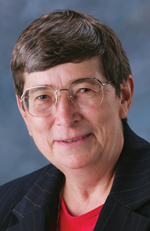(Editor’s note: This is the fifth of six talks we are publishing by local religious leaders who spoke at St. Ambrose University on Oct. 10, the vigil of the 50th anniverary of the opening of the Second Vatican Council. Sister Joan Lescinski, CSJ, is president of St. Ambrose.)
By Sister Joan Lescinski

Thank you, Father Chuck (Adam), for inviting me to offer a few minutes of reflection. To start, let me say that the Church recognizes Vatican II as a movement of the Holy Spirit. As you have heard from others already, the “new breeze” of the spirit touched every area of our Catholic lives.
In its final year, 1965, the council issued a decree entitled “On the Appropriate Renewal of Religious Life,” or in its Latin title: Perfectae Caritatis (of perfect charity). This document radically challenged those of us who belonged to religious communities like mine, the Sisters of St. Joseph of Carondelet. The council asked three things of us:
First, it challenged us to continue to find our inspiration in the Gospels, noting that “the ultimate norm of the religious life is the following of Christ set forth in the Gospels.” It said that this should be our “highest rule.”
Secondly, it asked us to return to the spirit and inspiration of our founders, or, as the council called it: to “return to the sources” to explore the founding vision and renew ourselves based on that vision. For CSJs like me, that meant very close examination of the spirit and time in which we were founded: 17th century France. We sent a team of Sisters to France to study those original documents and 17th century culture for nearly two years. And their report back energized us to answer the challenge of Vatican II to return to the spirit of the founders. But more on that shortly.
Thirdly, it called upon us to read “the signs of the times” and adapt ourselves and our way of living to the needs of the world today.
The first of those challenges: to find our inspiration in the Gospels. It called on Catholics and on religious to explore the riches of Scripture, something to which Roman Catholics came rather late. We learned a great deal from our other Christian brothers and sisters who had, for generations, made a much closer study of the Scripture an integral part of their spiritual lives.
The second of those challenges, to return to the spirit and inspiration of our founders, was particularly important since the canon law which governed religious life had not been changed since 1917. So most religious communities of women, like mine, looked alike: black long habits, cloisters in their homes, little activity in the communities in which they lived beyond the ministries to which they had been assigned, for example, hospital and school work.
When we returned to our founding inspiration, we discovered that we had been called to do all of which women were capable, that we were called to the “dear neighbor from whom we do not separate ourselves,” and that our first Sisters in 1650 did not wear a habit, but wore the dress of the times, that is the dress of 17th century widows. Dressing like widows freed those early Sisters to go about in society doing good works at a time when only widows could respectably do so in French society without a male escort. So we learned that the call to us was to put aside this now “foreign” dress that separated us from our brothers and sisters and, once again, in harmony with our original vision, to work with our neighbors and to dress like people of our times as we did all manner of good works.
The last of those challenges, to read the signs of the times, was given to the entire Church, and not just religious women and men, to see itself not against the world and apart from the world but in the world, a world which God created, Jesus redeemed, and the Spirit continues to sanctify. Some of the values of the world are not our values, but the world itself is a holy place in which our God lives.
And, finally, there is only one citation for the Vatican II document on appropriate renewal of religious life, and guess who they quote? St. Ambrose, in a work he composed on religious life entitled De Virginitate written in 378. So, in one remarkable document from the Second Vatican Council, the Church joins its most ancient traditions on religious life from the Gospels and the early Fathers with a very modern understanding of the place of religious in the world today. We can say, indeed, that the council opened the windows of our lives to this world, and that it enabled us to carry out this way of living discipleship to which all the baptized are called. Thank you.







